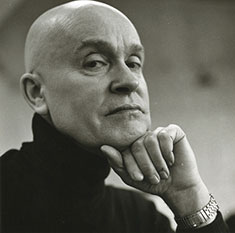| Gene Davis | |
|---|---|
 Photo by: Rosalind Solomon |
|
| Born | Aug. 22, 1920 Washington DC |
| Died | Apr. 6, 1985 (at age 64) |
| Nationality | American |
| Movement | Washington Color School, Color Field painting, Post-painterly Abstraction |
| Field | Painting |
| Works | View Complete Works |
The life of Gene Davis began in Washington, D.C., in 1920. The nation’s capital set the stage for Davis to eventually become the abstract painter he is best known for. With a background in journalism, Davis covered the Washington Redskins and covered the presidential terms of two presidents. Despite this, it was not until his exhibit at the Washington Gallery of Modern Art that his work begin to gain popularity.
Style and Technique
 Gene Davis began humbly perfecting his craft in a small one room studio in Washington, D.C. Even though he had no formal training, Davis reveled in the works of other famous painters as he visited classic modern art museums and galleries on the East Coast. His early paintings drew inspiration from artists like Paul Klee. His brilliant use of color and their near-perfect precision drew rave reviews from members of the art world. Although he worked in many different mediums, he is largely remembered for his work with acrylic paint on unprimed canvas. This use of color and paint was the premise of a group called the Washington Color School for which Davis was a central figure. His abstract paintings consisted of complex images and a huge focus on color.
Gene Davis began humbly perfecting his craft in a small one room studio in Washington, D.C. Even though he had no formal training, Davis reveled in the works of other famous painters as he visited classic modern art museums and galleries on the East Coast. His early paintings drew inspiration from artists like Paul Klee. His brilliant use of color and their near-perfect precision drew rave reviews from members of the art world. Although he worked in many different mediums, he is largely remembered for his work with acrylic paint on unprimed canvas. This use of color and paint was the premise of a group called the Washington Color School for which Davis was a central figure. His abstract paintings consisted of complex images and a huge focus on color.
Famous Works
 Largely known for his striped art, works such as Black Grey Beat, are still noted as one of the great pieces of abstract art today. This piece uses alternating stripes in black and grey while strategically placing blues, greens and pinks. The result is an interesting mix of contrasting hues. In 1972 he painted Franklin’s Footpath, by creating huge stripes directly in front of the Philadelphia Museum of Art. His creativity led him to create other works that involved portraits and collages.
Largely known for his striped art, works such as Black Grey Beat, are still noted as one of the great pieces of abstract art today. This piece uses alternating stripes in black and grey while strategically placing blues, greens and pinks. The result is an interesting mix of contrasting hues. In 1972 he painted Franklin’s Footpath, by creating huge stripes directly in front of the Philadelphia Museum of Art. His creativity led him to create other works that involved portraits and collages.
The abstract works of Gene Davis showcase his use of experimentation and color in his paintings. From his teachings at Corcoran Art School to his work as a member of the Washington Color School, Davis will remain a fixture in the world of abstract art. He died in 1985 of a heart attack in Washington, D.C., the place where his career began.